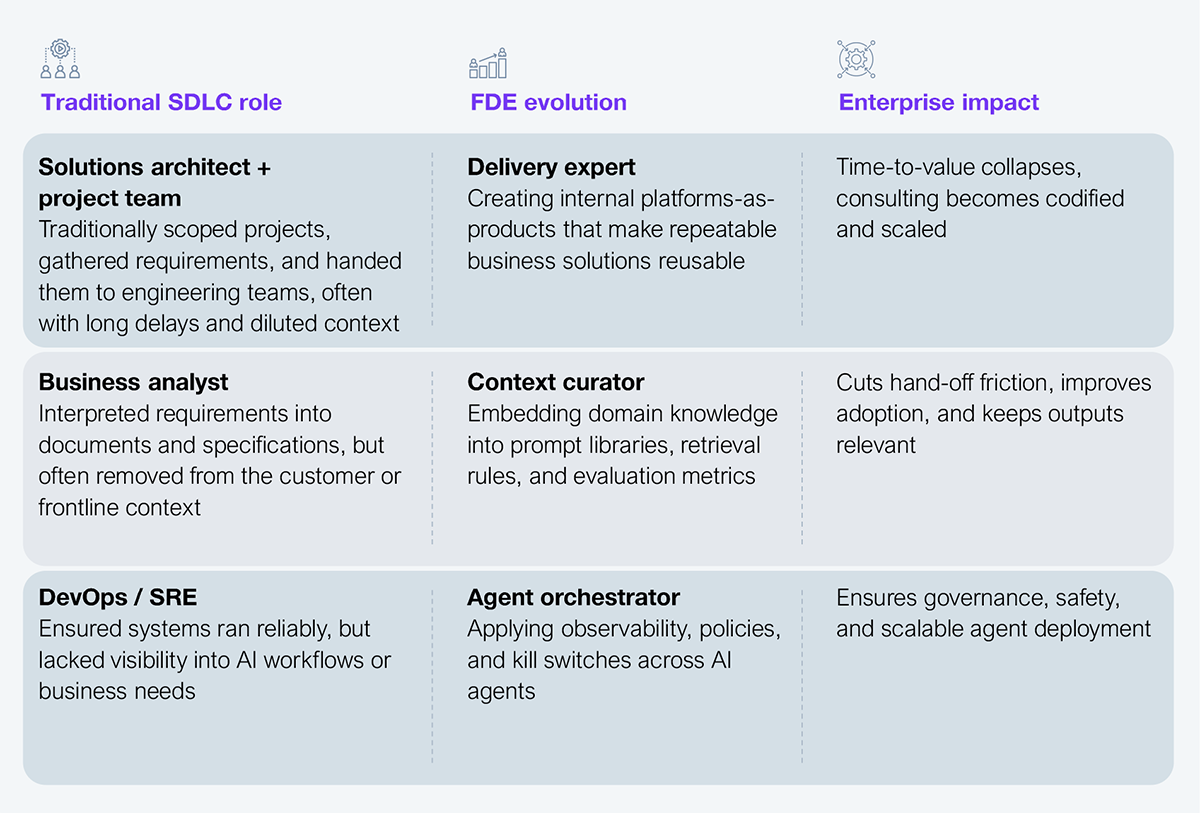How must a CTO act when business-led applications development outpaces software development lifecycles (SDLC) even as AI accelerates this gap? Low-code, no-code, and vibe-coding tools are coming together as a centerpiece of AI-led SDLC, giving business units the power to build their solutions quickly. But potentially without the guardrails of IT governance, security, or scalability. From a technology best practice, the CTO must be concerned with a growing sprawl of shadow applications, technology risk, and integration headaches that, lacking oversight, will slow the enterprise down.
We believe the Forward Development Engineers (FDEs) are the structural answer. First pioneered by Palantir and now on the rise across companies from OpenAI to Accenture, companies are beginning to embed FDEs as technical experts sitting alongside front-line employees to design, test, and operationalize software-based needs in real time. They combine domain, technical, and AI skills to turn rapid experimentation into enterprise-grade capability.
CTOs embedding FDEs are more likely to capture and control the innovation already happening in the business. They can turn experimentation into a governed, enterprise-grade capability. Without FDEs, AI-driven development will continue to grow outside IT’s oversight, creating systems that are harder to integrate, secure, and scale.
We built the software development lifecycle at a time when business change moved in years, not weeks. Roles such as business analysts, project teams, and solution architects were designed to translate requirements into systems at a predictable pace. We increased the magic of code with evolving languages and delivery models, from waterfall to Agile. However, the model breaks down when AI-driven experimentation occurs daily across business units.
FDEs represent the evolution of how IT teams can interact with business employees. Instead of following traditional SDLC structures, FDEs actively engage with planning, design, and coding handoffs. FDEs embed directly into the business and are responsible for collapsing cycle times while keeping governance intact.
FDEs are not consultants who advise and leave, nor are they a rebadged version of solution architects. They are embedded engineers who operate at the intersection of three disciplines:
Where they differ most from traditional SDLC roles is not just in skillset but also in placement and accountability. They sit inside business units as IT ambassadors. FDEs are accountable to business outcomes rather than the release schedule and operate continuously rather than episodically. For the CTO, this shift reconfigures the core responsibilities of traditional SDLC roles and creates new enterprise impacts (see Exhibit 1).

Source: HFS Research, 2025
Shadow AI is not a side effect. Rather, shadow IT is the default when business units move faster than IT. Low-code tools, vibe coding, and GenAI APIs make it easy for teams to spin up applications in days, often without security reviews, data controls, or integration plans. These ‘shadow apps’ solve immediate problems but create long-term risks from compliance failures, data exposure, and fragile systems that struggle to scale.
Forward Deployment Engineers cut this off at the source. Sitting inside the business unit allows them to embed enterprise guardrails into experimentation before it goes rogue. Their role works in three distinct ways:
The result is faster cycle times and a development model in which innovation happens within governance.
FDEs are not a plug-and-play, forget model. They demand a different operating model and mindset from the CTO to become respected collaborators. If enterprises treat them as just another flavor of solutions architect or project manager, they will get the worst of both worlds: shadow AI will run unchecked, and IT will still be too slow to matter. To succeed, CTOs must rethink how they structure teams, govern data, and measure value.
The leadership mandate falls into three shifts:
These shifts also mean rethinking metrics. Traditional SDLC success measures such as cost per release, lines of code, and uptime miss the point. FDEs should be judged by business-aligned outcomes: how quickly they turn prototypes into enterprise-grade systems, how effectively they prevent shadow AI, and how much revenue or customer impact they unlock.
For CTOs, the message is clear: FDEs are only as effective as the environment they are placed in. Without new foundations, structures, and measures, the enterprise will continue to lose the race between business speed and IT governance.
FDEs are the organizational response to democratizing technology creation, bridging the gap between citizen developers and enterprise-grade solutions. For the CTO, the opportunity is clear. Organizations must adopt the FDE model to turn rapid experimentation into governed, reusable business platforms that compound in value over time. Those who delay risk being constrained by shadow AI and fragmented tooling that erodes speed and control.
Register now for immediate access of HFS' research, data and forward looking trends.
Get StartedIf you don't have an account, Register here |
Register now for immediate access of HFS' research, data and forward looking trends.
Get Started